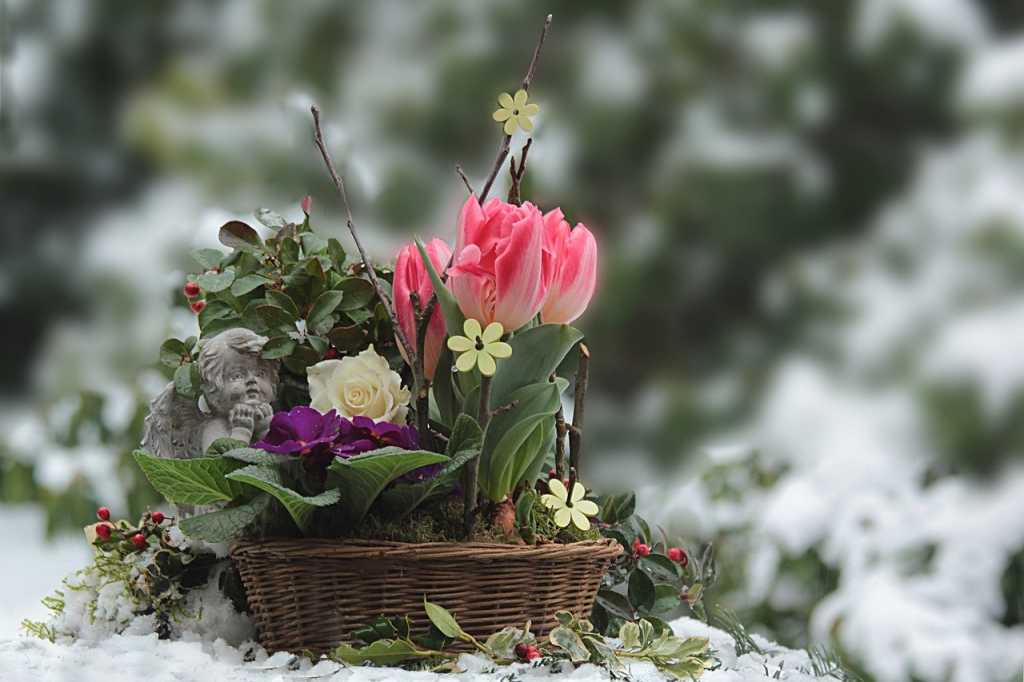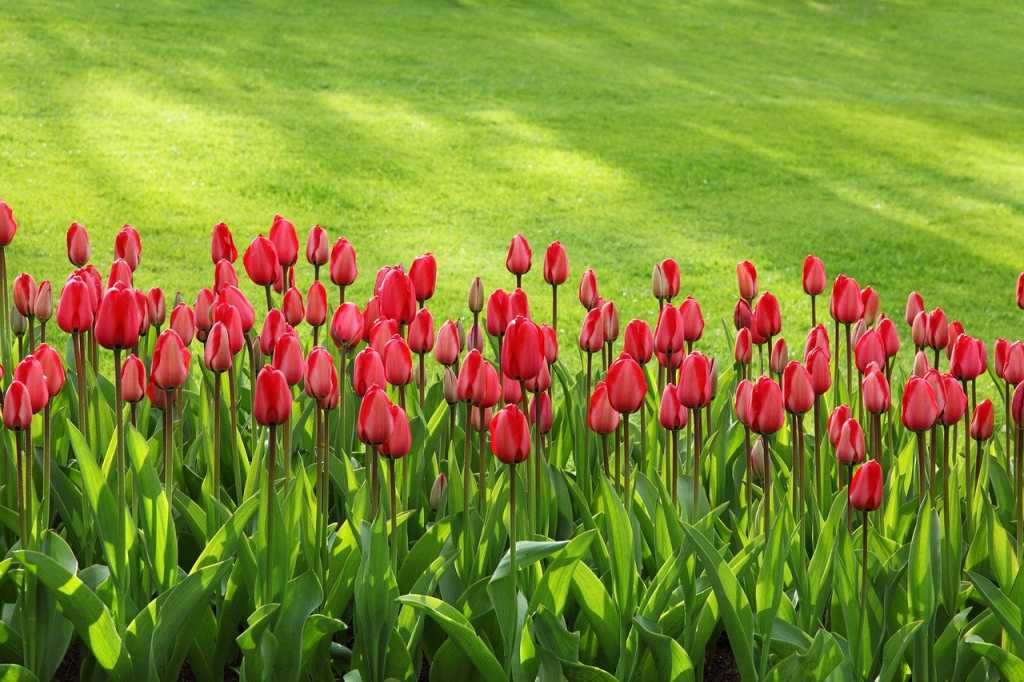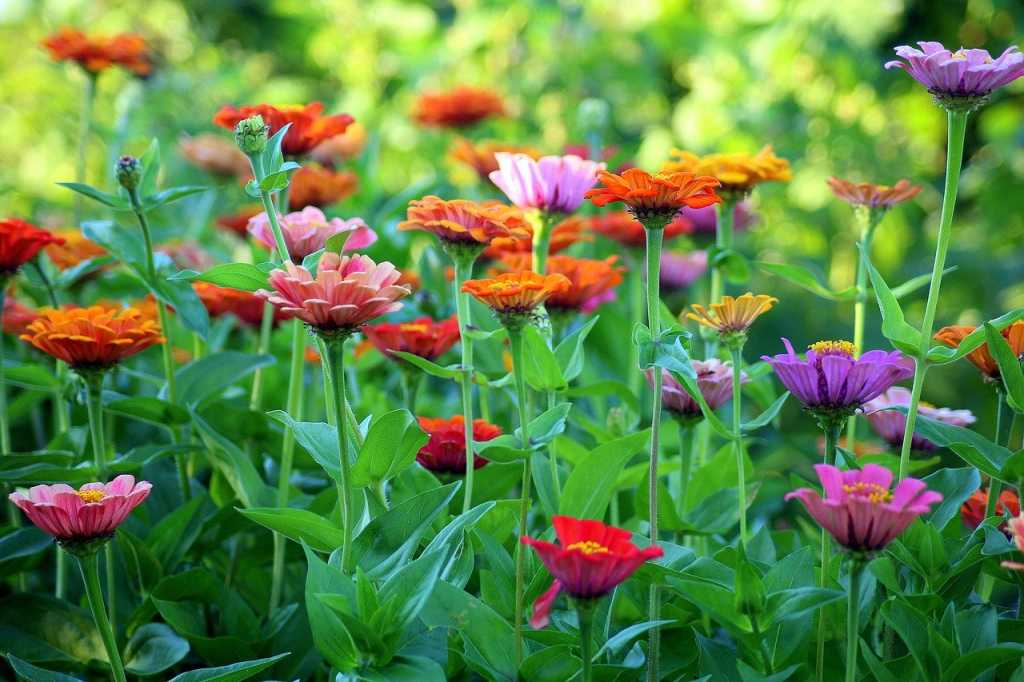The Best Gardening & Planting Calendar for 2020
As the seasons change, it can be difficult knowing when to start planting, cutting back trees and performing general landscaping work, so this month, R&J Landscapes are here to help you – with a planting calendar!
Jump to Month:
- Gardening In January
- Gardening In February
- Gardening In March
- Gardening In April
- Gardening In May
- Gardening In June
- Gardening In July
- Gardening In August
- Gardening In September
- Gardening In October
- Gardening In November
- Gardening In December
Gardening In January

What to do in January to my flower garden?
Dealing with water, frost and snow in the garden:
- If your garden is waterlogged, stay off the soil until it dries out to avoid compaction and spoiling the ground.
- If your lawn is frosty, do not walk on it, as this can cause the grass to fracture and leave visible footprint damage.
- If you’ve recently had snow, be sure to remove the snow off your shrubs as best you can by shaking it gently, this will prevent damage.
Pruning in January
- Prune bushes, apple trees and pear trees back to around 5 healthy main branches.
- If you’re a fan of sweet peas, these can be sown in January.
- Neaten and mulch borders.
- Water/soak deciduous hedges for at least an hour before planting.
- If you wish to move any deciduous trees and shrubs, January is the time to do this.
- For those delicate plants with protective winter coverings, give them a once-over to see how they’re doing.
What to do in January to my vegetable patch?
- For cruciferous vegetables, cabbages, or mustard plants (also known as brassicas) cover with cloches, netting or fleece to keep the birds away.
- If you have been growing any parsnips, sprouts, leeks or turnips – you can harvest these.
- Encourage new basal shoots by removing one-third of the old stems of blackcurrants.
Gardening In February
What to do in February to my flower garden?
Dealing with frost and snow in your garden:
- If you’ve had heavy snowfall, shake your shrubs to prevent damage.
Pruning in February
- Towards the end of February, cutback hard all coloured-stemmed Dogwood. Cut to around 6 inches above ground level. This will make it thrive and increase the number and quality of the display, next year.
- Prune roses, removing thin and weak growth and sealing up fresh cuts.
- For late summer flowering, prune clematis
- Using an edging iron, reshape your borders.
- Cutback tatty looking deciduous grasses towards the end of February.
- Get your kneepad out and weed your borders.
- Remove any dead, diseased or damaged wood found on trees and shrubs.
- Prune apple and fruit trees further, if necessary.
- Check for any emerging bulbs in your borders.
- Plant clematis and honeysuckle – they’re easy-to-grow climbers.
- For summer colour, now is the time to sow marigold, sunflowers, chrysanthemums, etc.
What to do in February to my vegetable patch?
- Plant seed potatoes and chit tubers in trays or egg boxes, somewhere cool like on a windowsill, where they’ll have enough light and remain frost-free.
- Sow crops such as broad beans and lettuce in a green-house.
- Start planting asparagus – remember to keep them free from weeds and use a mulch to provide them with rich organic matter.
- Use appropriate fertilisers on your borders.
- Mulch trees and fruit-bearing plants after pruning.
- You can start to plant garlic.
Gardening In March

What to do in March to my flower garden?
- Gently rake the lawn to remove moss – once the frost has gone and the water has dried up.
- Check over your trees and shrubs, removing dead, diseased or damaged spots as you go.
- Check over roses and cut away dead or dying shoots. Place manure or rose feed around roses to encourage growth.
- Remove fading or deadheads on flowers.
- Plant any new perennials and summer bulbs.
- Remove weeds as they pop up.
- If you haven’t already, you can still sow marigold, sunflowers, chrysanthemums, etc.
- Repair lawn damage – cut out damaged areas, lightly turn over the soil underneath, sprinkle on topsoil or compost, sow grass seeds and add another small layer of topsoil/compost, and water.
- Cut back herbaceous and grasses that remain from the winter.
- Divide your summer-flowering plants.
What to do in March to my vegetable patch?
- Prune red and white currants and gooseberry bushes, and remove deadwood. Move onto the side shoots and cut back between 2 to 3 buds from its base. For any long branches, shorten the tips by one quarter.
- Now is the time to plant shallots and onions.
- Once your winter crops have been harvested, compost healthy debris.
- If you have access to an indoor heated propagator, aubergines, chillies, cucumbers and tomatoes can now be sown.
Gardening In April
What to do in April to my flower garden?
- Carry on removing faded flowers on spring bulbs
- Check borders to ensure they’re weed-free.
- In mild weather, trim the weak or withering growth of any sage or rosemary.
- Lightly prune evergreens showing frost-damage. You can now plant new evergreens and move existing ones too.
- Treat any early signs of aphids.
What to do in April to my vegetable patch?
- Carry on planting potatoes and stop planting new onions by mid-April.
- Sow beetroot, carrots, radish, peas and spinach into your vegetable patch.
- Prune stone fruit trees, including cherry trees and plum trees, when leaf buds begin to open.
Gardening In May
What to do in May to my flower garden?
You will see fast growth in your garden in May time but watch out for late frosts that might catch any early blooms – remove damage quickly to ensure your healthy garden growth.
- Spray roses with insecticide/fungicides – following the label of your chosen solution.
- Continue to weed, as weed growth will be rapid in May.
- Watch out for dying flower heads of spring bulbs but do not remove any of its foliage until it has completely yellowed and withered.
- Neaten up any planted rosemary, thyme or sage if you haven’t already.
- Cutback withered the stems of withered tulips and daffodils.
- Tidy border edges.
- Tend to spring-flowering clematis with a quick prune.
- For any quick-growing herbaceous perennials, support them with stakes.
- If your daffodils failed to flower properly, remove, divide and replant.
- Any indoor flowers need to be hardened off by placing them outside to get them used to the natural elements, which will get them ready for planting.
What to do in May to my vegetable patch?
- It’s time to harvest your asparagus.
- Sow French beans and sweet corn, if you’re experiencing warm weather.
- Earth planted potatoes.
- Harvest radishes and lettuces.
- Don’t be tempted to plant tomatoes if the temperatures are 12C or below in May.
- Place pumpkins, cucumbers, courgettes and squashes under coverings at the start of May, and towards the end of the month place outside. You can leave netting on for protection.
Gardening In June
What to do in June to my flower garden?
- Be sure to deadhead flowers that are fading.
- Check plants over for black flies and aphids – spray if necessary.
- Continue weeding to ensure your garden isn’t overrun.
- Cut back browning leaves away from tulips.
- Shape shrubs or simply prune.
- Once the flowers of an ornamental cherry tree start to fade and die, prune them back.
- You still have time to sow quick germinating annuals in June, if you wish.
- Pansies, heathers, violas can be sown now, ideal for those wanting a colourful winter bedding.
What to do in June to my vegetable patch?
- If you’re wanting an autumn and winter harvest, sow carrots in June
- Chicory, fennel and florence can be sown – all are relatively easy to grow and have a long growing season.
- Once your leeks have the thickness of a pencil, they can be planted outside.
- To conserve moisture, you can mulch your strawberries now with black plastic or straw.
- For larger-growing potatoes, give them a good watering.
- Regularly fertilise tomatoes
- Open up your greenhouse and ensure it’s well-ventilated.
Gardening In July
What to do in July to my flower garden?
- Deadhead flowers as you garden (these are likely to be roses and herbaceous perennials).
- Spot-check weeds and continue to remove.
- Trim and edge borders to neaten.
- Cut back oriental poppies after their blooms have faded.
- Neaten evergreen hedges with a good trim.
- Using a pitch fork, turn over your compost.
- Fertilise dahlias, cannas and callas.
- Now’s the time to sow biennials, such as foxgloves.
What to do in July to my vegetable patch?
- Thin your apple trees and leave one fruit per cluster – this will ensure your trees bear the largest fruits.
- It’s time to sow cabbages for spring.
- Plant winter cabbages outside.
- Water courgettes regularly to ensure they grow large and healthy.
- Remember to mulch any long-term crops in your garden.
- Generously water fruit bushes and trees.
Gardening In August
What to do in August to my flower garden?
- Deadhead fading flowers. Pay attention to dahlias in August as they should be looking their best this month, so you will want to maximise their beauty by ridding the plant of any dying flower heads.
- Check for weeds, there shouldn’t be many but a quick once over will help to save time down the line.
- Mow the lawn. If the weather has been hot, raise the height of our mower’s blade to maintain a neat and healthy lawn.
- Trim along hedges and neaten them up.
- Water tired looking plants, try to do this towards the evening when the temperature is cooler.
- Spray and fertilise roses.
- Now is the time to think about planting autumn-flowering bulbs.
What to do in August to my vegetable patch?
- Once the leaves around your garlic bulbs have wilted and turned yellow, it’s time to use a trowel to loosen up and harvest the garlic.
- You can now sow mizuna, mibuna and pak choi.
- Pick early, ripe apples from fruit-bearing trees.
- Harvest potatoes.
Gardening In September
What to do in September to my flower garden?
- Rake up leaves that have fallen already.
- Clear your borders of weeds.
- Propagate perennials.
- Deadhead any flowers that have faded.
- Plant your spring bulbs in September so they will be ready for display next year.
- Carefully lift herbaceous perennials from the soil and separate them to ensure they’re healthy and bloom well next year.
- While the soil is still warm, it’s time to begin planting new trees and shrubs.
- If you wish to move any evergreen shrubs, it’s best to do so towards the end of September or early October, so that they can re-establish their roots swiftly.
What to do in September to my vegetable patch?
- Sweet corn should be ready to harvest in September, you can check to see if they’re ripe by seeing if their kernels contain a white liquid.
- Allow time for any squashes or pumpkins to ripen.
- Plant onions and shallots.
- Harvest fruit as it ripens.
- Harvest potatoes.
- Now you can sow winter greens, this includes mustard spinach and kale.
Gardening In October
What to do in October to my flower garden?
- Now is the time to use your compost to mulch your borders – this organic matter will keep them healthy and will help to suppress weeds.
- Tidy up roses, removing fallen leaves and petals to prevent black spot (a disease that affects the health of roses).
- Plant daffodil bulbs.
- Fertilise your lawn.
- Last chance to plant new trees and shrubs, if you haven’t already.
- Refill any bird feeders.
What to do in October to my vegetable patch?
- Plant new garlic.
- Cover late-season crops if there is going to be frost.
- Lift and separate rhubarb carefully.
- Prevent disease and pests by removing dead foliage away from strawberry patches.
- Remove herbs from the garden, put them into pots and place in a frost-free greenhouse.
- Now it’s time to harvest any pumpkins, squash and other late-season vegetables that are ready.
Gardening In November
What to do in November to my flower garden?
- To ensure your roses do not get wind-rock, prune roses further.
- Now is the last chance to mow your lawn but only if there isn’t any frost.
- Rake up piles of leaves and place them into a compost heap.
- Finish planting new bulbs at the start of November.
- Skim surface of ponds to remove any sludge or fallen leaves.
- Stay off wet or frosty lawns.
What to do in November to my vegetable patch?
- Prune all fruiting trees.
- Plant new fruit trees.
- Wrap gel bands around the trunks of fruit trees – this stops pests from climbing and nesting inside trees.
- Use mature compost on any patchy areas of the ground.
- Discard any dead plants.
- Protect salad plants with a fleece covering.
Gardening In December
What to do in December to my flower garden?
- Tidy all borders and remove fallen leaves one last time before Christmas.
- Check over any newly-planted shrubs, plants, trees and bulbs to ensure that they haven’t experienced any wind-rock damage.
- Stop pruning when there’s snow or frost.
- You can still mulch your garden if the weather remains mild.
What to do in December to my vegetable patch?
- Harvest winter vegetables.
- Cover outdoor taps to prevent freezing.
- Air out greenhouses on mild days.
If you require any help and assistance with your outdoor space, contact R&J Landscapes. We provide a number of services including paving, driveway and landscape services, turfing, tree work, tree surgery and general garden maintenance. Operating throughout Harrow, Aylesbury, Berkhamsted, St Albans and Watford, our friendly team are here to offer comprehensive services to our local customers.



